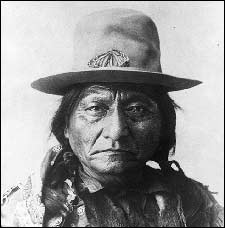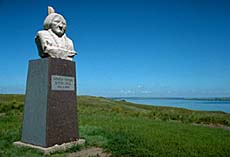|
|
Around 1831, Sitting Bull was born on or near the Grand River in present-day South Dakota at which the Lakota's called, "Many Caches." |
| Tatonka -Iyotanka was the name given to Sitting Bull. It standed for a Buffalo Bill sitting intractably on its haunches. As the years pasted, Sitting Bull became a leader of the Strong Heart warrior society. |
| Sitting Bull, at the age of 14 years old went to his first battle in a "Raid on the Crow," and met his first encounters in his whole life which was the American soldiers. In June of 1863, when the army mounted a campaign in retaliation for the Santee Rebellion held in Minnesota. There was no reason for Sitting Bull's people to attend because they played no part in it. |
| In 1865, Sitting Bull as a siege against a new Fort Rice that has just been established which was in present-day North Dakota. In 1868, Sitting Bull became a head chief of the Lakota nation. |
| When Sitting Bull turned 15 years old he showed people of the nation the great courage that he had during a war with the Flat Head's in 1847. During the battle he only suffered with small foot wounds. When the warrior society came to the Lakota nation, they were called, "the finest light cavalry in the world." It meant that people who fought had a strong heart. The last known person that was head of the "Cante Tinza" society. |
| In 1872.Sitting Bull led four warriors out between the lines and sat quietly why everyone sat around smoking a pipe as bullets were shooting every which direction. |
| In 1874, a war broke out between Sitting Bull and the U.S. Army, when suddenly a group led by General George Armstrong Custer confirmed to everyone that he and his band found gold that had been discovered in the Black Hills around the Dakota Territory. The Dakota Territory is often placed off limits to only white settlements set by the Fort Laramie Treaty of 1868. |
| When government efforts chose to purchase the Black Hills, the Black Hills failed. When that happened the Fort Laramie Treaty was set aside and commissioners of Indian Affairs decreed that all Lakota's in the Lakota nation are not settled on reservations by January 31st, 1876, they would be considered hostile. |
| In May 1877, Sitting Bull led his band across the border into Canada, beyond the reach of the U.S. Army and when General Terry traveled north to offer him a pardon in exchange for setting on reservation which Sitting Bull found out and sent him away. |
| On July 19,1881, Sitting Bull had his young son hand his rifle to the commanding officer of Fort Buford in Montana, he said that in this way he hoped to teach the boy "that he became a friend of the Americans." |
| After Sitting Bull went to Fort Buford, he was sent to Fort Randall, where he and his followers were held for 2 years as prisoners of war. On May 10,1883, Sitting Bull came back and rejoined his own tribe at Standing Rock. In 1885, Tatonka-Iyotanka decided to leave the reservations where he lived and went and joined Buffalo Bill's Wild West Show. He earned $50.00 a week for riding around the arena once during a show. He was so popular that he was charging people at the shows to get an autograph and a picture. The show lasted him about 4 months. |
| Sitting Bull again moved back to Standing Rock where he lived in a cabin on the Grand River. In 1890, police rushed into Sitting Bull's house and killed him for no reason at all. Now he lies at Fort Yates cemetery in North Dakota. |
|
|
| We can remember Sitting Bull for these great words of his: |
| "If the Great Spirit had desired me to be a white man he would have made me so in the first place. He put in your heart certain wishes and plans, and in my heart he put other and different desires. It is not necessary for eagles to be crows." |
|
-Sitting Bull |
 IT
IT